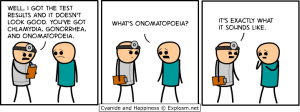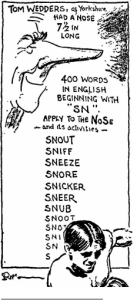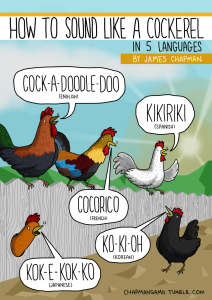Language is fairly incredible, when you think about it. One system, based on anatomical possibilities within the vocal tract or the sign space, is able to express literally anything we need it to express. We may wish simply to say “I walk,” meaning that the speaker engages in a very simple motion in the present time, easily demonstrated. However, we can also discuss more complex topics, everything from foreign policy to literature to general relativity.
One reason for this vast range of uses is what linguists call “arbitrariness.” Arbitrariness is language’s ability to use a series of sounds to represent a word with no direct connection to the meaning of the word the sounds represent. For example, when you think of a furry, four-legged animal that barks, you may associate the word “dog” with that animal. There is nothing in the sounds “d”, “o”, or “g” that has anything to do with the dog. This can be demonstrated with the variety of sounds used to describe that same animal, even within a related language family: dog, chien, perro, hund. This difference between sound and meaning allows language to be flexible. Can you imagine how difficult it would be to explain an abstract concept like time if the sounds of the language had to have some connection to the meaning of the words they represent?
While most of the phonetic makeup of a word is arbitrarily determined, there is some degree of non-arbitrariness in language. The classic example is onomatopoeiae, when words sound like what they mean. Think of comic book words: boom! crash! zoink! But there are also many other types of non-arbitrariness, or “sound symbolism” (or “iconicity” or “phonosemantics”) in language. When you begin to dig into the research on the subject, you find some pretty cool things.
In some cases, sound symbolism is based on the physical aspects of how the sound is produced. Take the sound “ee” as in “peek.” Say it out loud and notice how big your mouth is. It’s pretty small, right? The tongue is near the front of the mouth, and the mouth does not open very far. Your lips stretch back a little bit, in a smile, which is why people are asked to say “cheese” when taking a picture (try to smile while saying “oops”; it can’t be done, at least, not attractively). Compare saying “peek” to “ahh.” In “ahh” your mouth is much more open, which is why doctors ask you to say it when they check your throat.
The physical smallness of the sound “ee” when it is produced is important for sound symbolism. Cross-linguistically (in many different, unrelated languages), the sound “ee” is used to denote smallness, or something endearing. Think of English words like teeny weeny, or adding -ie to words to make them cuter, i.e. “doggie.” The Spanish suffixes -ito and -ita work in the same way. Hermanita is the more intimate form of hermana, which means sister. Hungarian has the suffixes -i and -csi to make a name cuter, which use the same vowel sound.
Another example of sound symbolism relying on physical production of the sound is called the “Bouba/Kiki Experiment.” The Bouba/Kiki Experiment is one of the most well-known psychological experiments in language. The task was fairly simple. Subjects were shown a picture of two objects (see below), one in a spiky shape and one a more Nickelodeon-style curvy blob. They were given two words : “bouba” and “kiki,” and they were asked to label the two objects with those words. Overwhelmingly, the word “bouba” was assigned to the curvier blob and the word “kiki” was assigned to the spikier blob. This result has been replicated with several different, unrelated languages. Why is it that this effect is so robust? One of the explanations is that the round blob more closely matches the shape of the mouth for “bouba,” where the lips are rounded, whereas the narrow spiky blob matches the narrow, angular way the mouth opens for “kiki.” Even as I write this, I have a little bit of discomfort writing the words “spiky blob,” because the word “blob” seems too rounded to represent the kiki shape.
Another form of sound symbolism is the combination of sounds resulting in words with certain meanings at better-than-chance rates. For example, think of words that start with gl-: glitter, gleam, glow, glimmer. All of those words have something to do with reflected light. Sometimes, the same consonant cluster can be different for different people. Br- is strongly gendered, for example, with very stereotypically female roles in words relating to feeding and taking care of people, as in bread, braise, breast-feed, etc. and for men this is where we find words like brute and brawn. A really lovely, extensive list of these types of words is available here through John Lawler’s website.
There are some people who even think all words contain sound symbolism in one form or another. While that may be a little extreme, I think it’s clear that there are definitely strong forces of non-arbitrariness at work. However, keep in mind that even with a clearly sound-symbolic word, there can be interlinguistic differences. See the comic below, and the many lovely illustrations of linguistic differences on a wide variety of topics on James Chapman’s website.






Pingback: Does Your Accent Determine Your Friends? | Beyond the Fourth Floor
Pingback: What Exactly Are Vowels and Consonants? | Beyond the Fourth Floor